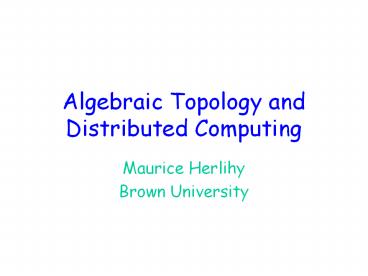Algebraic Topology and Distributed Computing PowerPoint PPT Presentation
Title: Algebraic Topology and Distributed Computing
1
Algebraic Topology and Distributed Computing
- Maurice Herlihy
- Brown University
2
Overview
- Focus on applications of algebraic topology to
fault-tolerant computing - model
- techniques
- Joint work with Sergio Rajsbaum, Nir Shavit, Mark
Tuttle
3
First Part of Talk
- Focus on one problem
- Consensus
- One model of computation
- synchronous message-passing
- Motivation
- results not new (those come later)
- but illustrate model
4
The Consensus Task
Before private inputs
After agree on one input
5
The Model Synchronous Message-Passing
Round 0
Round 1
6
Failures Fail-Stop
Partial broadcast
7
Summary
- Consensus
- all processes agree on some input
- Model
- processes run in lock-step
- non-faulty processes broadcast
- faulty processes broadcast to subset
8
Road Map
- Next mathematical model
- combinatorial topology
- no interesting mathematics (yet)
- but want to focus on model
- and basic approach
9
A Vertex
Point in high-dimensional Euclidean Space
10
Simplexes
1-simplex (edge)
2-simplex (solid triangle)
11
Simplicial Complex
12
Simplicial Maps
- Vertex-to-vertex map
- carrying simplexes to simplexes
- induces piece-wise linear map
13
Vertex Process State
Process id (color)
7
Value (input or output)
14
Simplex Global State
15
Complex Global States
16
Initial States for Consensus
0
- Processes blue, red, green.
- Independently assign 0 or 1
- Isomorphic to 2-sphere
- the input complex
0
1
0
1
17
Final States for Consensus
- Processes agree on 0 or 1
- Two disjoint n-simplexes
- the output complex
18
Problem Specification
- For each input simplex S
- relation D(S)
- defines corresponding set of legal outputs
- carries input simplex
- to output subcomplex
19
Consensus Specification
Simplex of all-zero inputs
20
Consensus Specification
Simplex of all-one inputs
21
Consensus Specification
Mixed-input simplex
22
Protocols
- Finite program
- starts with input values
- fixed number of rounds
- halts with decision value
23
Generic Protocol
Number of rounds
s empty sequence for (i0 iltr i)
broadcast messages s s messages received
return d(s)
Decision map
24
Protocol Complex
- Each protocol defines a complex
- vertex sequence of messages received
- simplex compatible set of vertexes
- Treat as operator on input simplex
- Model of computation defines protocol complex
properties
25
Single Input Round Zero
- No messages sent
- vertexes labeled with input values
- isomorphic to input simplex
0
0
0
26
Round Zero Protocol Complex
- No messages sent
- vertexes labeled with input values
- isomorphic to input complex
27
Single Input Round One
red fails
green fails
no one fails
blue fails
28
Protocol Complex Round One
29
Protocol Complex Round Two
30
Protocol Complex Evolution
zero
one
two
31
Observation
- Decision map
- is a simplicial map
- vertexes to vertexes, but also
- simplexes to simplexes
- respects specification relation D
32
Summary
d
Protocol complex
D
Input complex
Output complex
33
Proof Strategy
Find topological obstruction to this simplicial
map
d
Protocol complex
Output complex
34
Consensus Example
Subcomplex of all-zero inputs
d
Protocol
Output
must map here
35
Consensus Example
Subcomplex of all-one inputs
d
Protocol
Output
must map here
36
Contradiction
not connected
d
Protocol
Output
connected
37
Theorem
- In any (n-1)-round protocol complex
- the all-zero subcomplex
- and the all-one subcomplex
- are connected
- Corollary
- no (n-1)-round consensus protocol
38
Remarks
- Consensus result is
- not exactly new PSL 80
- and doesnt really need topology
- but illustrates basic approach
- use topological techniques
- to prove non-existence of simplicial map
39
Next Part of Talk
- Connectivity of protocol complexes
- define notion
- Analyze protocol complexes for
- message-passing
- read/write memory
- memory with stronger operations

